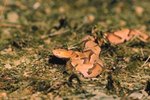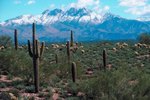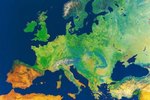The U.S. is the natural home of three types of venomous spiders: widows, recluses and hobos. Hobos are the least widespread, found primarily in the Pacific Northwest. Numerous types of recluses, including the most famous, the brown recluse, roam around many parts of the country. Also widespread in America are five types of widow spiders, including three varieties of black widow. Of all these, only one is indigenous to Minnesota: the Northern black widow.
State Distribution
The Northern black widow is the only venomous spider with populations occurring naturally in the U.S. state of Minnesota. Fifteen other states have just one indigenous poisonous spider, and it just so happens that the Northern black widow is also the single resident in 11 of these 15 states. Maine is the only U.S. state with no indigenous venomous spiders. The Northern black widow is the most widespread poisonous spider in the country, naturally inhabiting 34 of the 50 states.
Description
Northern black widows have shiny black exteriors. Unlike the other types of black widows in the U.S.—Southern and Western black widows—they don't usually feature a full red-orange hourglass on the underside of the abdomen; instead, Northerns typically have a pair of reddish bars on the top of the abdomen and another on the underside. They also have a progression of red spots along the abdomen's top midline. Although size varies, females average about half an inch long with a 1 1/2-inch-long leg span; males are generally less than half this size. Like all spiders, Northern black widows have a cephalothorax with the head and eight legs, and an abdomen bearing web spinnerets. Widows' abdomens are much larger than their cephalothoraxes, and their spinnerets resemble clusters of cones.
Habitat and Webs
Northern black widows prefer dark places where they can spin their webs and await prey. They don't typically wander around. Across Minnesota, these widows are drawn to making their homes in bushes, brush or woodpiles, hollowed-out logs, fences, sheds, garages, crawlspaces, abandoned animal burrows and similar out-of-the-way, sheltered places. They aren't prone to going indoors, but do sometimes; when they do, they'll usually head for a quiet, dark location. Webs of Northern black widows resemble cobwebs more than more classic round spiderweb.
Bites
Minnesotans aren't at great risk of being bitten by a Northern black widow; the greatest risk is outdoors. Examine woodpiles, sheds, bushes and other areas for cobwebs. Bites are rare, since Northern black widows are skittish and prone to retreat. Accidental contact with a web is the most likely scenario to result in a bite. The venom of Northern black widows is highly toxic—15 times more so than that of a rattlesnake—but little is released relative to a human's size. Less than 1 percent of bites result in fatalities, most often those in small children. Effects vary widely, depending on the size and sensitivity of the person bitten, the bite's location and depth and how recently the widow released venom with another bite. Bites become painful within 15 minutes to an hour. Symptoms usually last about 24 hours and include aching, cramping, nausea, vomiting, itching, sweating, fever, increased blood pressure, irregular heartbeat and spasms or tremors.
References
Writer Bio
Eric Mohrman has been a freelance writer since 2007, focusing on travel, food and lifestyle stories. His creative writing is also widely published. He lives in Orlando, Florida.




